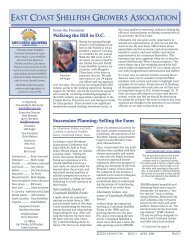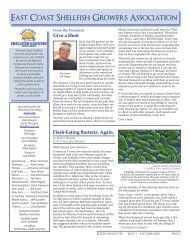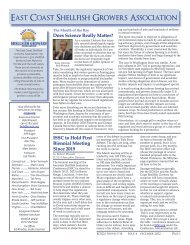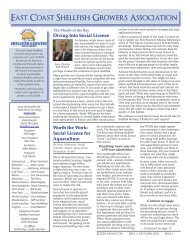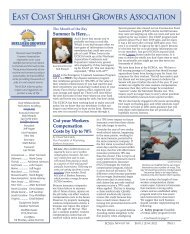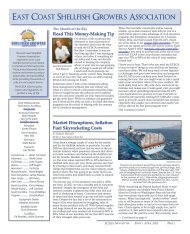East Coast Shellfish Growers Association August 2021 Newsletter
Read about the new disaster assistance for shellfish growers from the Farm Service Agency:ELAP; the death of Walt Canzonier; a win for South Carolina growers with help from allies; new biodegradable netting from Ketcham Supply; Prop 65 warnings; shellfish farm ecosystem services study.
Read about the new disaster assistance for shellfish growers from the Farm Service Agency:ELAP; the death of Walt Canzonier; a win for South Carolina growers with help from allies; new biodegradable netting from Ketcham Supply; Prop 65 warnings; shellfish farm ecosystem services study.
You also want an ePaper? Increase the reach of your titles
YUMPU automatically turns print PDFs into web optimized ePapers that Google loves.
The Nature Conservancy, Partners Release Global Study
Quantifying Habitat Benefits of Shellfish Aquaculture
The Nature Conservancy
The Nature Conservancy and partners at
University of New England, University of
Melbourne and University of Adelaide systematically
reviewed 65 published sources from
around the world to assess the biodiversity benefits
of mussel, oyster, clam and seaweed farms.
Across all species groups, a greater number
of fish and invertebrates were observed on the
farm sites compared to nearby locations. Mussel
farms appear to be the most beneficial of
these species groups for enhancing the volume
of marine life, as about 3.6 times more fish
and invertebrates appear around mussel farms
compared to nearby locations.
In addition, a greater diversity of species was
also observed on some farm sites. Oyster farms
proved to be the most effective for increasing
species diversity: 30 percent more species
tended to inhabit these farms than areas near
the farm. These benefits were the result of providing
a structured habitat, food and places to
forage, and reproductive grounds for fish.
“Aquaculture is among the world’s fastestgrowing
forms of food production and there is
a growing biodiversity crisis that already exists
in our ocean. It’s critical that we identify ways
to develop aquaculture that benefits, rather
than harms our ocean, that are based on sound
science,” said Robert Jones, Global Lead for
Aquaculture at The Nature Conservancy and
co-author on the study. “This study is game
changing in that it clearly shows an opportunity
through shellfish and seaweed aquaculture.
For the first time, we’re able to put quantifiable
global numbers on the benefits these farms can
have on marine wildlife.”
The authors hope that policymakers at local,
regional and global levels will recognize the
potential positive outcomes provided by aquaculture
and begin to incorporate them into
regulatory systems that encourage the development
of a habitat-positive industry, potentially
creating public incentives and market-based
approaches that will allow farmers to be rewarded
or compensated for the benefits they
are providing.
“When managed and practiced well, commercial,
market-driven shellfish and seaweed
farming can provide ecosystem services,” said
Dr. Seth Theuerkauf, the study's lead author
and former Global Aquaculture Scientist at
The Nature Conservancy. “This means that
we have another tool in the coastal ecosystem
recovery toolbelt that can be deployed by the
private sector to produce food while providing
the ecosystem services that we so desperately
need in many systems.”
More broadly, the authors hope that the example
of shellfish and seaweed farming systems
can provide an important case study that
inspires application and development of aquaculture
and agriculture that is nature-positive,
while also helping to provide food security.
“For decades we have thought these benefits
may be real. It is fantastic to see these results
quantify this positive habitat value from aquaculture,”
said Dr. Barry Costa-Pierce, Henry
L. & Grace Doherty Professor of Ocean Food
Systems at University of New England.
To read the full study, Habitat value of bivalve
shellfish and seaweed aquaculture for fish and
invertebrates: Pathways, synthesis and next
steps, visit doi.org/10.1111/raq.12584.
— See graphic on page 15
SHELLFISH GROWER
INSURANCE
Call for Commercial Boat Insurance!
Remember:
Keep ‘Em
Cold
General Liability
Jones Act
Business Auto/Truck
Workers’ Compensation
Marine/Boat
All Others
CONNECT WITH
David Merriman, CPCU
Sales Executive
Phone: 434-327-1643
dmerriman@bankersinsurance.net
www.bankersinsurance.net/seafood
Bankers Insurance focuses on you, the client,
and endeavors to become your trusted
insurance agent. We are committed to No
Excuse Client Service and pride ourselves on
delivering the highest ethical and professional
standards. Contact David, today!
Do you sell shellfish
at farmers markets or
other retail outlets?
For as little as $4.75 each
(for 250) you can buy
custom–imprinted,
soft–sided, insulated
lunch boxes. Throw in a gel
pac and your customers
will be able to keep their
shellfish purchases safe and
cool on the ride home.
For more info, visit
ePromos.com
Page 14 ECSGA Newsletter Issue 3 August 2021




